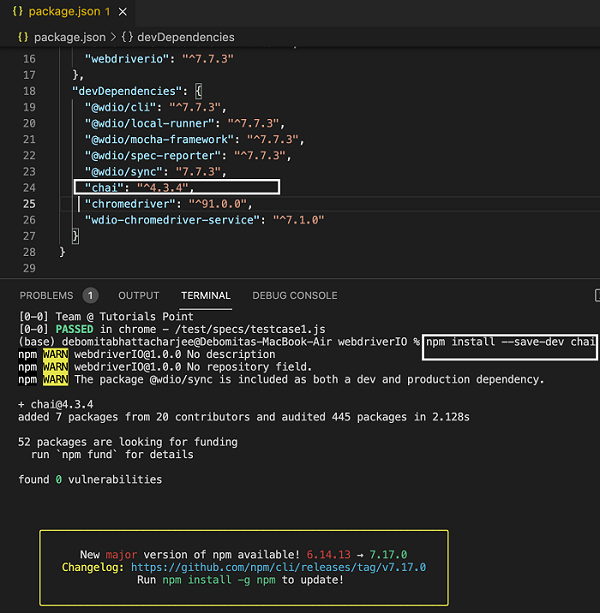
- WebdriverIO 教程
- WebdriverIO - 首頁
- WebdriverIO - 簡介
- WebdriverIO - 前提條件
- WebdriverIO - 架構
- WebdriverIO - 使用 NodeJS 入門
- WebdriverIO - NPM 的安裝
- WebdriverIO - VS Code 安裝
- WebdriverIO - package.json
- WebdriverIO - Mocha 安裝
- Selenium 獨立伺服器安裝
- WebdriverIO - 配置檔案生成
- WebdriverIO - VS Code 智慧感知
- WebdriverIO - wdio.conf.js 檔案
- WebdriverIO - XPath 定位器
- WebdriverIO - CSS 定位器
- WebdriverIO - 連結文字定位器
- WebdriverIO - ID 定位器
- WebdriverIO - 標籤名稱定位器
- WebdriverIO - 類名定位器
- WebdriverIO - 名稱定位器
- 斷言的 Expect 語句
- WebdriverIO - 成功路徑流程
- WebdriverIO - 通用瀏覽器命令
- WebdriverIO - 處理瀏覽器大小
- WebdriverIO - 瀏覽器導航命令
- 處理複選框和下拉列表
- WebdriverIO - 滑鼠操作
- 處理子視窗/彈出視窗
- WebdriverIO - 隱藏元素
- WebdriverIO - 框架
- WebdriverIO - 拖放
- WebdriverIO - 雙擊
- WebdriverIO - Cookie
- WebdriverIO - 處理單選按鈕
- Chai 斷言在 Web 元素上
- WebdriverIO - 多個視窗/標籤頁
- WebdriverIO - 滾動操作
- WebdriverIO - 警報
- WebdriverIO - 除錯程式碼
- WebdriverIO - 捕獲螢幕截圖
- WebdriverIO - JavaScript 執行器
- WebdriverIO - 等待
- WebdriverIO - 並行執行測試
- WebdriverIO - 資料驅動測試
- 從命令列引數執行測試
- 使用 Mocha 選項執行測試
- 從 Allure 生成 HTML 報告
- WebdriverIO 有用資源
- WebdriverIO - 快速指南
- WebdriverIO - 有用資源
- WebdriverIO - 討論
WebdriverIO - Chai 斷言在 Web 元素上
Chai 是一個用於 Node 的斷言庫。它主要用於 BDD 和 TDD 框架。它可以輕鬆地與任何 JavaScript 測試框架整合。Chai 的官方文件可在以下連結中找到:
要安裝 Chai 並將其新增到 package.json 檔案中,請執行以下命令:
npm install --save-dev chai
有關 package.json 檔案的詳細資訊將在標題為“package.json”的章節中詳細討論。
您的計算機上將顯示以下螢幕:

安裝後,我們必須新增以下語句以在我們的程式碼中新增期望風格的 Chai。
require('chai').expect
語法
Chai 斷言的語法如下:
const c = require('chai').expect
c(p.getValue()).to.equal('subject')
讓我們實現一個 Chai 斷言,並驗證以下下拉列表中選擇的選項是否符合預期結果。

有關如何處理下拉列表的詳細資訊將在“處理下拉列表”章節中詳細討論。
首先,請按照“使用 WebdriverIO 的成功路徑流程”章節中的步驟 1 到 5 操作,步驟如下:
步驟 1 - 安裝 NodeJS。有關如何執行此安裝的詳細資訊在“使用 NodeJS 入門”章節中詳細介紹。
步驟 2 - 安裝 NPM。有關如何執行此安裝的詳細資訊在“NPM 的安裝”章節中詳細介紹。
步驟 3 - 安裝 VS Code。有關如何執行此安裝的詳細資訊在“VS Code 安裝”章節中詳細介紹。
步驟 4 - 建立配置檔案。有關如何執行此安裝的詳細資訊在“配置檔案生成”章節中詳細介紹。
步驟 5 - 建立一個規範檔案。有關如何執行此安裝的詳細資訊在“Mocha 安裝”章節中給出。
步驟 6 - 在建立的 Mocha 規範檔案中新增以下程式碼。
require('chai').expect
//import chai library
const c = require('chai').expect
describe('Tutorialspoint application', function(){
//test case
it('Drodowns with Chai Assertion', function(){
// launch url
browser.url('https://tutorialspoint.tw/tutor_connect/index.php')
//identify dropdown
const p = $("select[name='selType']")
//select by index
p.selectByIndex(1)
//get option selected
console.log(p.getValue() + ' - option selected by index')
//verify option selected with chai assertion
c(p.getValue()).to.equal('name')
//select by visible text
p.selectByVisibleText('By Subject')
//get option selected
console.log(p.getValue() + ' - option selected by visible text')
//verify option selected with chai assertion
c(p.getValue()).to.equal('subject')
//select by value attribute
p.selectByAttribute('value', 'name')
//get option selected
console.log(p.getValue() + ' - option selected by attribute value')
//verify option selected with chai assertion
c(p.getValue()).to.equal('name')
});
});
使用以下命令執行配置檔案 - wdio.conf.js 檔案:
npx wdio run wdio.conf.js
有關如何建立配置檔案的詳細資訊在“wdio.conf.js 檔案”和“配置檔案生成”章節中詳細討論。
您的計算機上將顯示以下螢幕:

成功執行命令後,首先會在控制檯中列印使用選項索引 - name 選擇的選項的值。然後,會在控制檯中列印使用可見文字 - subject 選擇的選項的值。最後,會在控制檯中列印使用屬性值 - name 選擇的選項的值。
此外,我們還獲得了 PASSED 結果,表明應用於下拉列表的所有 Chai 斷言都已透過。
讓我們實現另一個 Chai 斷言,並驗證獲取的警報文字是否符合預期結果。

有關如何處理警報的詳細資訊將在“警報”章節中詳細討論。
首先,請按照“使用 WebdriverIO 的成功路徑流程”章節中的步驟 1 到 5 操作,步驟如下:
步驟 1 - 安裝 NodeJS。有關如何執行此安裝的詳細資訊在“使用 NodeJS 入門”章節中詳細介紹。
步驟 2 - 安裝 NPM。有關如何執行此安裝的詳細資訊在“NPM 的安裝”章節中詳細介紹。
步驟 3 - 安裝 VS Code。有關如何執行此安裝的詳細資訊在“VS Code 安裝”章節中詳細介紹。
步驟 4 - 建立配置檔案。有關如何執行此安裝的詳細資訊在“配置檔案生成”章節中詳細介紹。
步驟 5 - 建立一個規範檔案。有關如何執行此安裝的詳細資訊在“Mocha 安裝”章節中給出。
步驟 6 - 在建立的 Mocha 規範檔案中新增以下程式碼。
//import chai library
const c = require('chai').expect
// test suite name
describe('Tutorialspoint application', function(){
//test case
it('Alerts with Chai Assertion', function(){
// launch url
browser.url('https://the-internet.herokuapp.com/javascript_alerts')
//identify element with xpath then click
$("//*[text()='Click for JS Prompt']").click()
//check if Alert is open
console.log(browser.isAlertOpen())
//get Alert Text
console.log(browser.getAlertText() + ' - Alert Text')
//verify Alert text with Chai assertion
c(browser.getAlertText()).to.equal("I am a JS prompt")
//accept Alert
browser.acceptAlert()
});
});
使用以下命令執行配置檔案 - wdio.conf.js 檔案:
npx wdio run wdio.conf.js
有關如何建立配置檔案的詳細資訊在“wdio.conf.js 檔案”和“配置檔案生成”章節中詳細討論。
您的計算機上將顯示以下螢幕:

成功執行命令後,首先會在控制檯中列印 true,因為它是由 browser.isAlertOpen() 方法返回的。然後,會在控制檯中列印警報文字 - 我是一個 JS 提示。
此外,我們還獲得了 PASSED 結果,表明應用於警報文字的 Chai 斷言已透過。